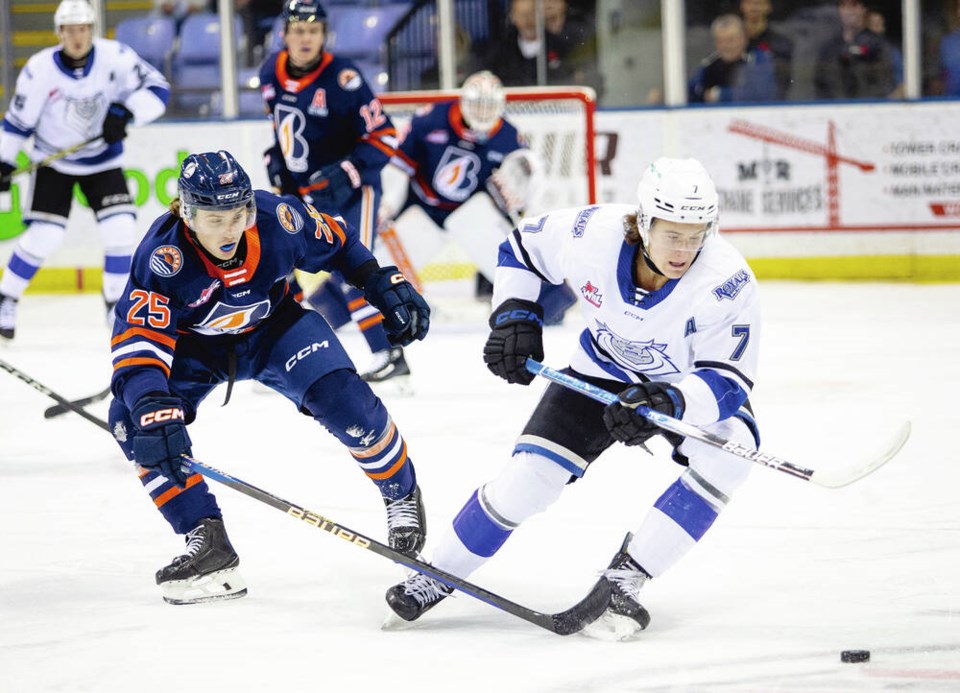The greatest landscape change in a generation in North American junior and university hockey took place Thursday with the NCAA vote to allow players from the major-junior Canadian Hockey League to play in the U.S. collegiate NCAA.
The NCAA had previously considered the CHL a pro league because it provided modest stipends for its players.
The Victoria Royals of the Western Hockey League are part of the CHL, which encompasses the WHL, Ontario Hockey League and Quebec Maritimes Junior Hockey League.
Joey Poljanowski, vice-president of hockey operations for the Royals, said he had no comment and that WHL teams have been instructed to refer all questions to the league.
The WHL issued a statement from commissioner Dan Near reading: “Today’s announcement that CHL players will now be eligible to compete in NCAA Div. 1 hockey, beginning in the 2025-26 season, represents a historic and consequential outcome. This decision creates opportunity for the brightest elite hockey players in Western ÎÚÑ»´«Ã½ and the Western U.S. to now choose the WHL as the preferred destination for their development from the age of 16-20, without fear of compromising their NCAA eligibility. We look forward to the opportunity to welcome a new wave of talent.”
The CHL used to dominate the NHL draft but that prominent status has steadily eroded to now where NHL draft picks come almost evenly one-third each from the CHL, NCAA and Europe.
For the North American Junior ‘A’ level of hockey, however, the decision is a major blow since that previously was the only path to NCAA Div. 1 for Canadian and American junior players. Now that advantage has been curtailed dramatically for Junior ‘A’ circuits such as the ÎÚÑ»´«Ã½ Hockey League.
David Michaud, president of the Victoria Grizzlies of the BCHL who are in action tonight hosting the Alberni Valley Bulldogs at The Q Centre, said he had no comment and referred all questions on the matter to the BCHL. So did Grizzlies head coach and GM Rylan Ferster, adding only that this will not direct him away from the usual conversations he has with potential recruits.
The BCHL issued a statement reading: “With today’s decision by the NCAA to allow CHL players eligibility for Division 1 hockey, the BCHL remains committed to its development model of preparing student athletes for college hockey. The BCHL has been around for 63 years and has been a pipeline to the NCAA for decades with league alumni currently making up 25 percent of all [NCAA] Division 1 players. The BCHL … will continue to adapt to the changing landscape of junior hockey.”
The move, or anticipation of it, is already having ramifications. Prize 16-year-old forward Noah Kosick from Victoria signed with the Calgary Hitmen, the team which drafted him 11th overall in the first round of the 2023 WHL prospects draft. Kosick is committed to the University of Michigan Wolverines of the NCAA Big Ten and began this season with Sioux Falls of the junior USHL. His move to the Hitmen was in anticipation of the vote to allow players to move from CHL major-junior teams to the NCAA.
Also, in anticipation of the vote, the home-Island Royals took a chance and selected Eli McKamey of Cowichan Bay in the second round, 35th overall, in the 2024 WHL prospects draft. McKamey was considered a sure-fire first-round WHL selection if he had not indicated he was considering the NCAA. The Royals now have a free pathway to pursue the projected high 2027 NHL draft pick from the Island, even if he does eventually go the NCAA route. McKamey, the first player granted exceptional status to play in the BCHL as a 15-year-old, decided to go with the Penticton Vees of the BCHL this season to keep alive his NCAA eligibility under the old rules. He is now free to join the Royals if he wishes next season without losing his chance to play in the NCAA.
“Eli is a great kid and we’ve had good conversations with him and his representatives. We look forward to those continued conversations,” said Royals GM Jake Heisinger.
The biggest caveat to the NCAA vote is that junior-age players under NHL pro contracts will not be allowed to play in the NCAA, which is good for the CHL, as pro-contracted junior-age players are the lifeblood at the top end of the WHL, OHL and QMJHL.



